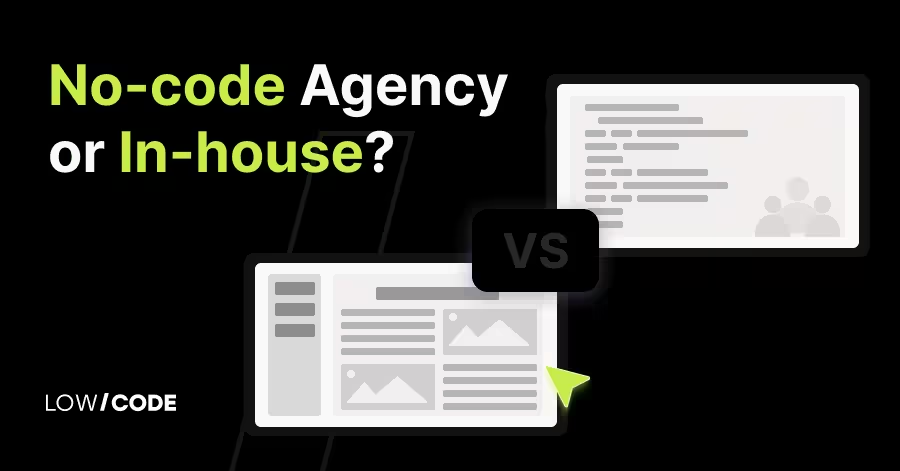No-code Automation: Tools, Use Cases & How to Get Started
8 min
read
Learn how no-code automation saves time, reduces errors, and connects tools like Slack, Airtable, and CRMs without writing code

What Is No-code Automation?
No-code automation means using visual tools to automate tasks without writing any code. It helps you connect apps, move data, and run workflows without needing technical skills. These tools are built for non-developers, using drag-and-drop interfaces and simple logic blocks.
- Definition: Automating tasks without writing code
You can set up actions like sending emails, updating databases, or assigning tasks by using visual steps. No programming is required. - Built for non-developers using visual tools
Platforms like Make and Zapier let you create automations by linking tools like Gmail, Google Sheets, or Slack using plain-language rules and menus. - Difference from low-code automation (optional)
No-code requires no programming knowledge at all. Low-code, on the other hand, may involve some light scripting or configuration for advanced control. It’s better suited for tech-savvy users or developers.
No-code automation is perfect for teams that want to save time, reduce manual work, and improve workflows—without writing a single line of code.
Hire LowCode Agency to Build Automation Solutions
LowCode Agency specializes in transforming business operations through custom no-code automation solutions. With over 330 successful projects completed, we help companies eliminate manual workflows and streamline their processes using powerful platforms like Make, Zapier, Bubble, Glide, and FlutterFlow.
Our team understands that every business faces unique operational challenges. Rather than offering one-size-fits-all solutions, we design tailored automation systems that integrate seamlessly with your existing tools and workflows. From simple task automation to complex multi-system integrations, we build solutions that scale with your business growth.
Ready to eliminate time-consuming manual processes and boost your team's efficiency? Book a free discovery call with our automation experts to discuss how we can streamline your specific workflows and drive measurable results for your business.
Why Use No-code Automation?
No-code automation is changing how businesses handle day-to-day tasks. Instead of relying on developers or spending hours on manual work, teams can now use visual tools to build automations that save time and improve efficiency. Whether you're running a startup or managing a growing team, no-code automation offers real value.
- Saves time by removing repetitive manual work
Everyday tasks like data entry, email follow-ups, or file transfers can be automated with just a few clicks. This allows your team to focus on work that actually moves the business forward. - Increases speed of operations
Automations run instantly, without breaks or delays. You can respond to leads, update systems, or notify your team in real-time, speeding up your entire process. - Reduces human error
Mistakes happen when people handle repetitive tasks. Automation ensures consistency by following the same steps every time, helping improve accuracy and reliability. - Cuts operational costs
Automating routine work means you can do more with fewer people. It reduces the need for manual labor and lowers the cost of running your business. - Makes automation accessible to anyone, not just developers
Tools like Make and Zapier use drag-and-drop features, so even non-technical team members can build powerful automations without writing a single line of code.
No-code automation is an easy and affordable way to improve how your business runs—faster, smarter, and with fewer errors.
Read more | Business Process Automation Benefits
Popular Use Cases for No-code Automation
No-code automation can be used across many areas of a business, helping you work faster and more efficiently without writing any code. Here are some of the most popular and practical use cases:
- Invoice and finance tracking
Automatically generate invoices, send payment reminders, or update accounting sheets when a sale happens. This saves time and reduces errors in financial records. - Auto-reply and ticket routing in customer support
When a support ticket or message is received, automation tools can send an instant reply, assign it to the right team member, and log it into your CRM or help desk. - Connecting apps (e.g., form > CRM > email)
When someone fills out a form on your website, no-code automation can send the details to your CRM, trigger a welcome email, and create a task for your sales team—all automatically. - Procurement process automation
Automate order requests, approvals, and vendor communication. You can set up flows that notify managers, log items in spreadsheets, or update inventory levels. - Client onboarding for service businesses
Send welcome emails, collect documents, assign internal tasks, and notify your team—all through one automated workflow. This helps deliver a consistent experience for every new client. - Internal meeting scheduler for remote teams
Automatically find meeting times, send calendar invites, and share agendas. This reduces back-and-forth and saves time for everyone. - Automated Bug Resolution and IT Troubleshooting
At LowCode Agency, we built a smart troubleshooting workflow using Make.com, OpenAI, and Slack. When a "400 error" occurs, the system identifies the issue, sends it to ChatGPT for analysis, and shares the fix with the team via Slack—reducing manual work and speeding up resolution.
These use cases show how no-code automation can improve operations across different teams and tasks.
Read more | Business Process Automation Challenges
Best No-code Automation Tools in 2025
1. Bubble (for centralized solutions)
Bubble stands out as a comprehensive no-code platform that lets you build complete web applications with sophisticated automation capabilities built right in. Rather than connecting external tools, you can create centralized solutions that handle everything from user management to complex business logic within a single platform.
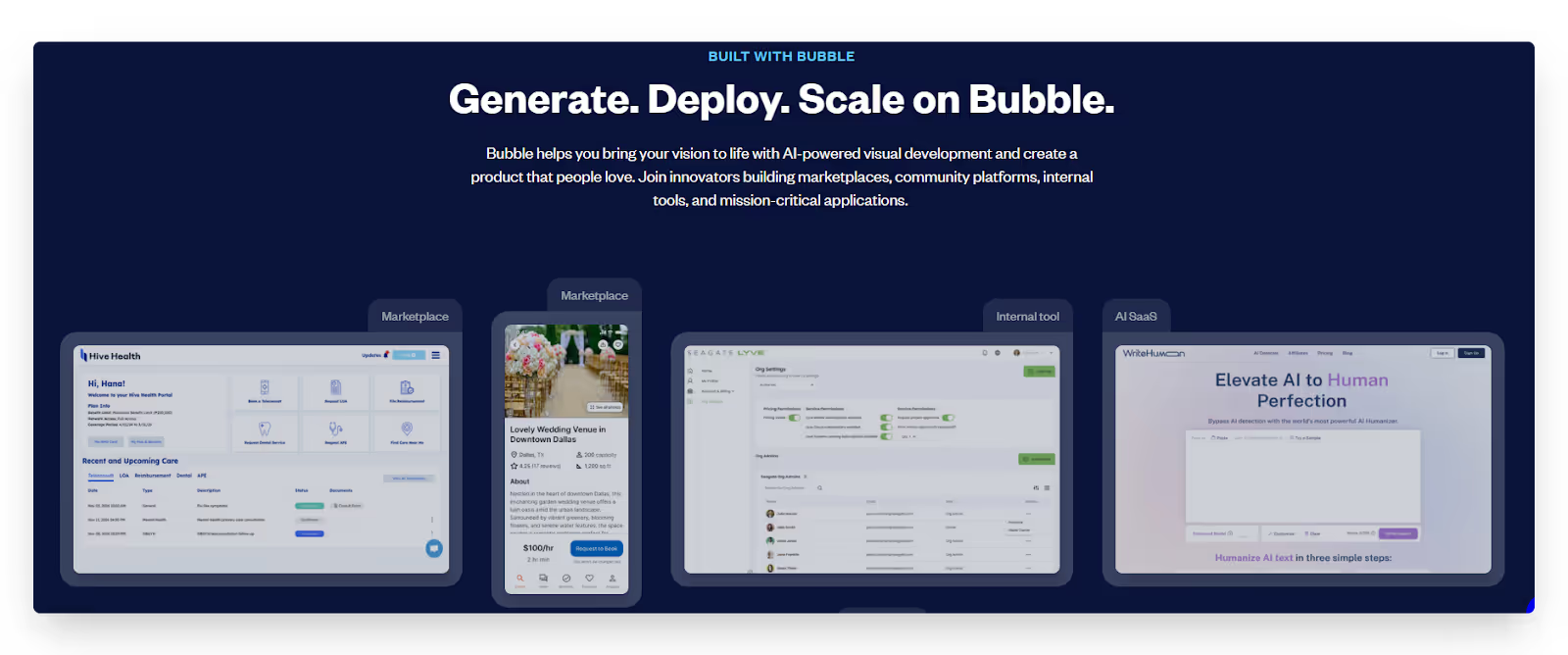
Unique features: Visual workflow editor with conditional logic, built-in database management, API integrations, and the ability to create custom user interfaces alongside your automation. Bubble excels at creating all-in-one business applications where automation is deeply integrated with user interactions and data management.
Limitations: Steeper learning curve compared to simple automation tools, and it's primarily focused on web applications rather than pure workflow automation. The platform requires more setup time but delivers more comprehensive solutions for complex business needs.
Read more | Business Process Automation Detailed Guide
2. FlutterFlow
FlutterFlow enables you to build native mobile applications with built-in automation features, making it perfect for businesses that need mobile-first solutions with automated workflows. The platform combines app development with powerful automation capabilities for creating comprehensive mobile business tools.

Unique features: Native mobile app creation with integrated automation, real-time data synchronization, custom code capabilities when needed, and seamless deployment to iOS and Android app stores. FlutterFlow excels at creating mobile apps that automate business processes on-the-go.
Limitations: Primarily focused on mobile applications, which may not suit businesses needing web-based automation. The platform requires understanding of mobile app design principles and may be overkill for simple workflow automation needs.
Read more | Business Process Automation Examples
3. Glide
Glide transforms several data sources into powerful automated applications with minimal setup time. It's particularly effective for creating internal business tools that automate data management and team workflows without requiring technical expertise.

Unique features: Data source-to-app conversion, real-time data sync, role-based access controls, and integrated automation triggers. Glide excels at creating data-driven applications where automation flows naturally from existing business data and processes.
Limitations: Limited to relatively simple automation scenarios and heavily dependent on data sources like Google Sheets or Airtable. Advanced conditional logic and complex integrations may require workarounds or external tools.
Read more | Business Process Automation in Healthcare
4. Zapier
Zapier remains the go-to solution for connecting different apps and automating simple workflows between them. With over 7,000 app integrations, it's the most accessible entry point for businesses wanting to automate routine tasks without technical complexity.
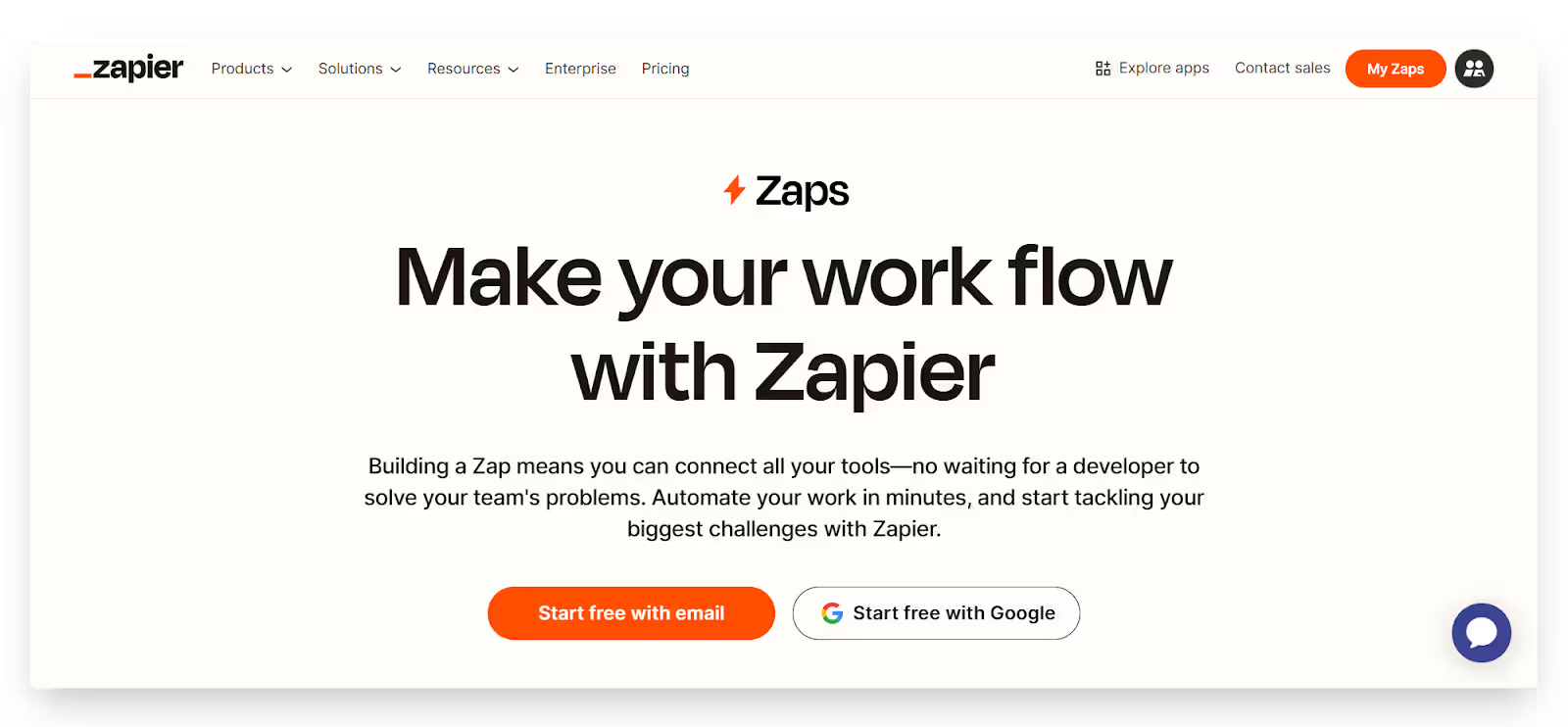
Unique features: Massive app ecosystem, pre-built automation templates called "Zaps," simple trigger-action logic, and excellent customer support resources. Zapier excels at straightforward automations like "when this happens in App A, do that in App B."
Limitations: Can become expensive as your automation needs grow, limited conditional logic compared to more advanced platforms, and multi-step automations can be cumbersome to manage. Complex business logic often requires multiple separate Zaps.
Read more | Business Process Automation Types
5. Make
Make (formerly Integromat) offers more sophisticated automation capabilities with visual workflow builders that can handle complex business logic and branching scenarios. It's designed for users who need more control over their automation flows than simple trigger-action setups.
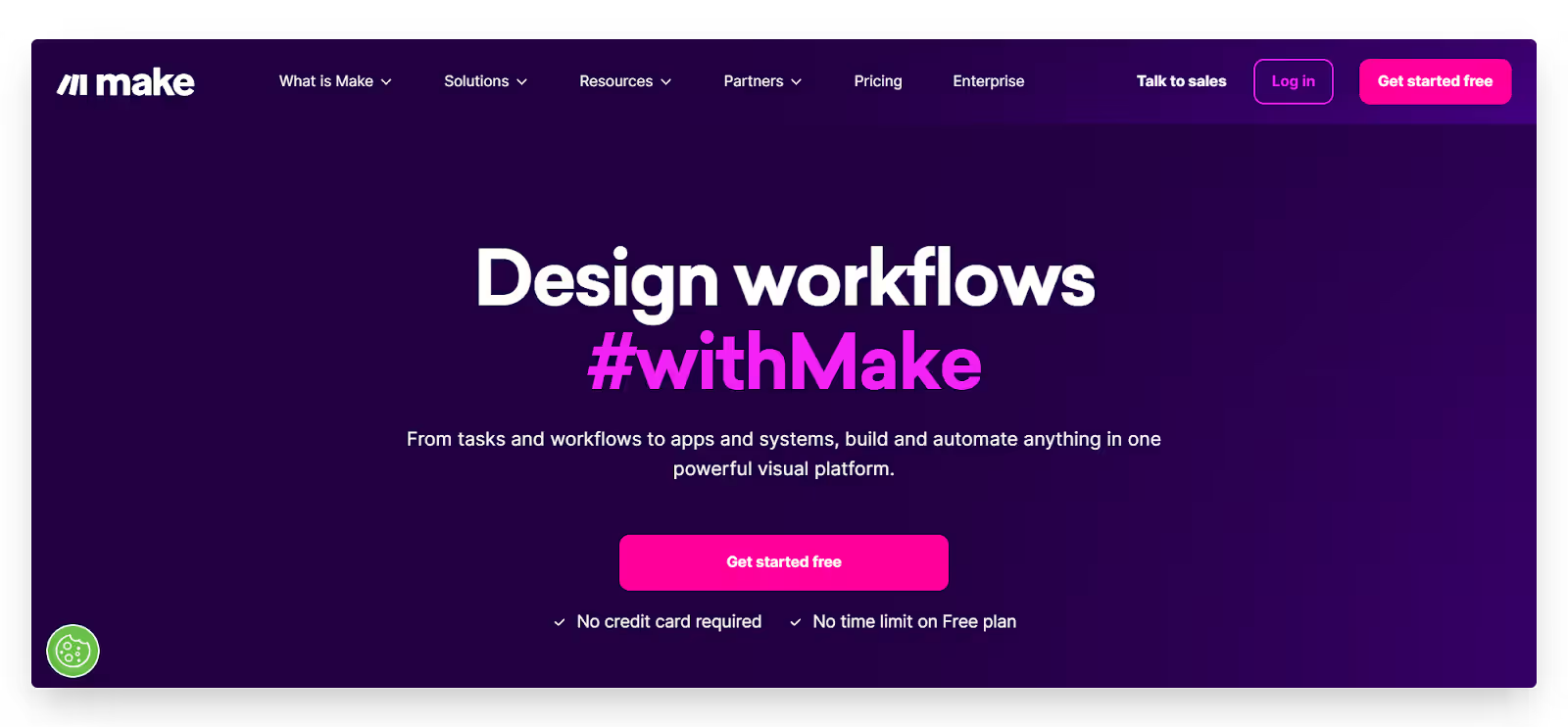
Unique features: Visual scenario builder with advanced routing, error handling, and data transformation capabilities. Make excels at complex automations involving multiple conditions, loops, and data manipulation across various applications.
Limitations: Steeper learning curve than simpler tools like Zapier, and the visual interface can become cluttered with complex scenarios. Pricing can escalate quickly for businesses with high-volume automation needs.
Read more | Low-code business process automation
6. n8n
n8n provides an open-source automation platform that offers both cloud and self-hosted options. It's particularly appealing for businesses with specific security requirements or those wanting complete control over their automation infrastructure.
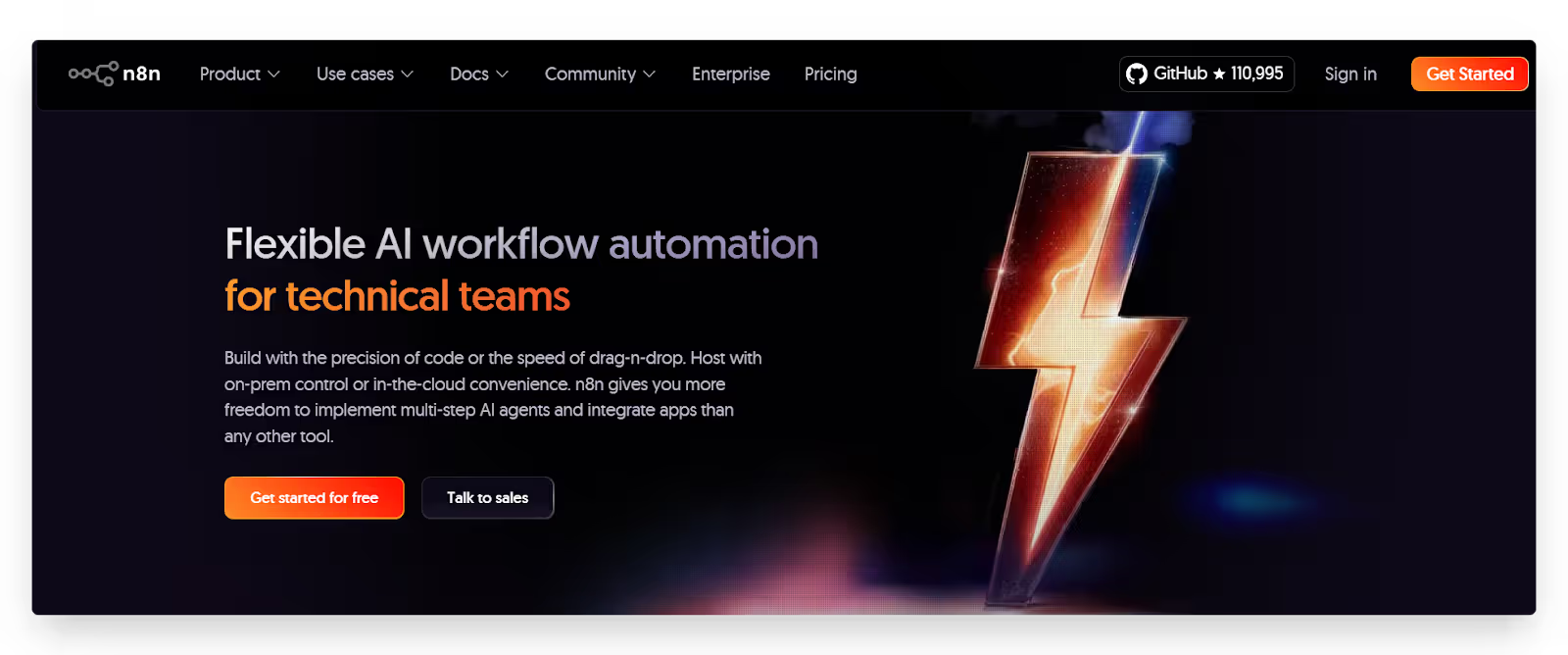
Unique features: Open-source flexibility, self-hosting capabilities, extensive customization options through custom nodes, and no vendor lock-in. n8n excels for technical teams who want to build and maintain their own automation infrastructure.
Limitations: Requires more technical expertise to set up and maintain, especially for self-hosted deployments. The smaller ecosystem means fewer pre-built integrations compared to commercial alternatives.
Read more | No-code automation tools
7. Pipefy
Pipefy combines process management with automation, making it ideal for businesses that need to formalize and automate their workflow processes. It provides structure for teams while automating routine tasks within those processes.
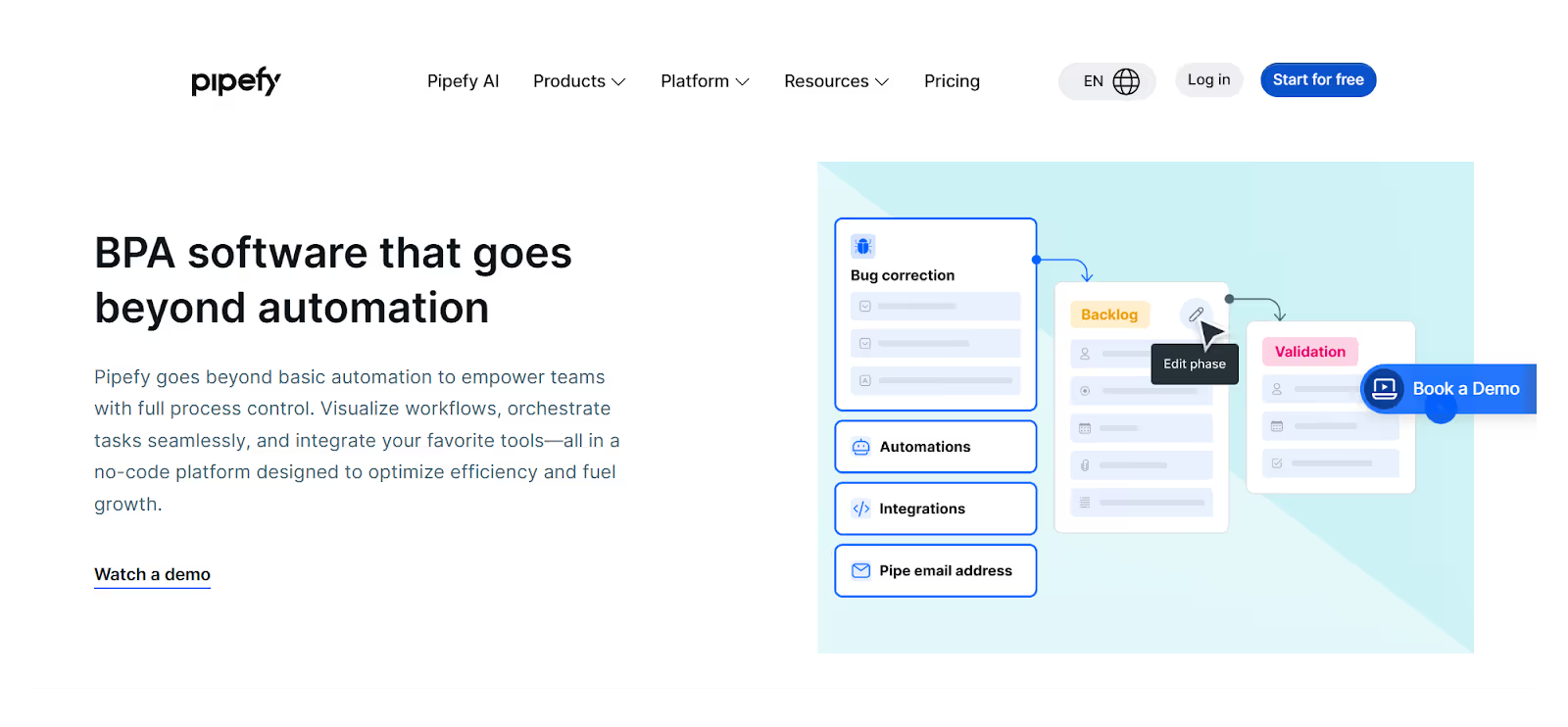
Unique features: Process templates for common business workflows, kanban-style process visualization, automated task assignments and notifications, and integration capabilities with popular business tools.
Limitations: More focused on process management than pure automation, which may be overkill for simple task automation needs. The platform works best when you're willing to restructure existing processes around its methodology.
Read more | Build Minimum Viable Product for eCommerce
8. Kissflow
Kissflow offers a comprehensive digital workplace platform that combines workflow automation with process management and collaboration tools. It's designed for businesses wanting an all-in-one solution for process digitization.

Unique features: Pre-built business process templates, approval workflows, reporting dashboards, and collaboration features. Kissflow excels at replacing paper-based processes with automated digital workflows.
Limitations: Can be overwhelming for businesses only needing simple automation, and the comprehensive feature set may include unnecessary complexity for straightforward workflow needs.
Read more | AI Contract Management
9. Unito
Unito specializes in keeping different project management and collaboration tools synchronized in real-time. It's particularly valuable for teams using multiple platforms that need to maintain data consistency across systems.
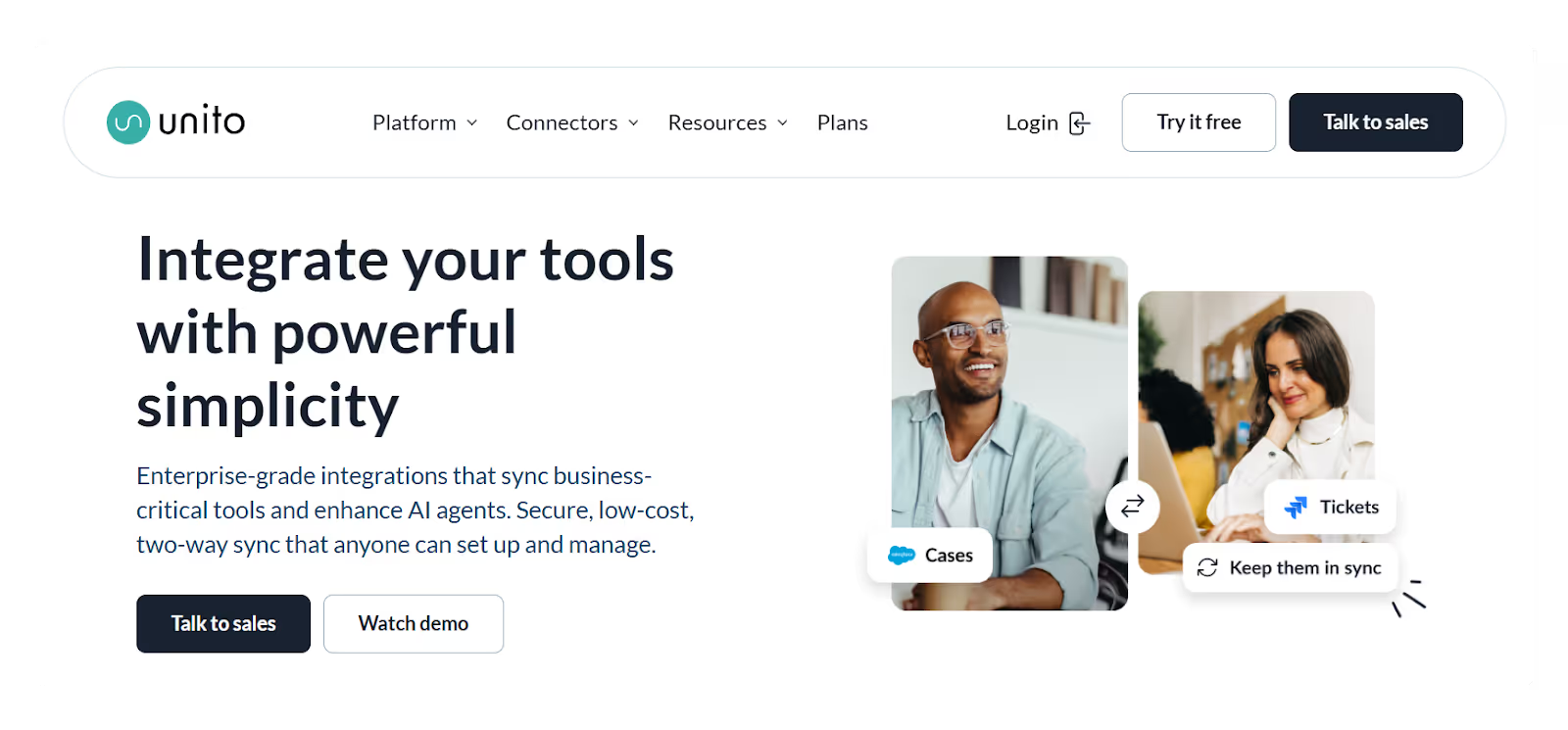
Unique features: Two-way synchronization between project management tools, real-time updates across platforms, and field mapping capabilities. Unito excels at eliminating data silos between different team collaboration tools.
Limitations: Focused specifically on project management and collaboration tool integration, making it less suitable for broader business automation needs. Limited to synchronization rather than complex workflow automation.
Read more | Benefits of Glide AI-Powered Apps
10. Power Automate
Microsoft Power Automate integrates seamlessly with the Microsoft ecosystem while providing automation capabilities across hundreds of other applications. It's particularly powerful for businesses already invested in Microsoft 365 and related services.
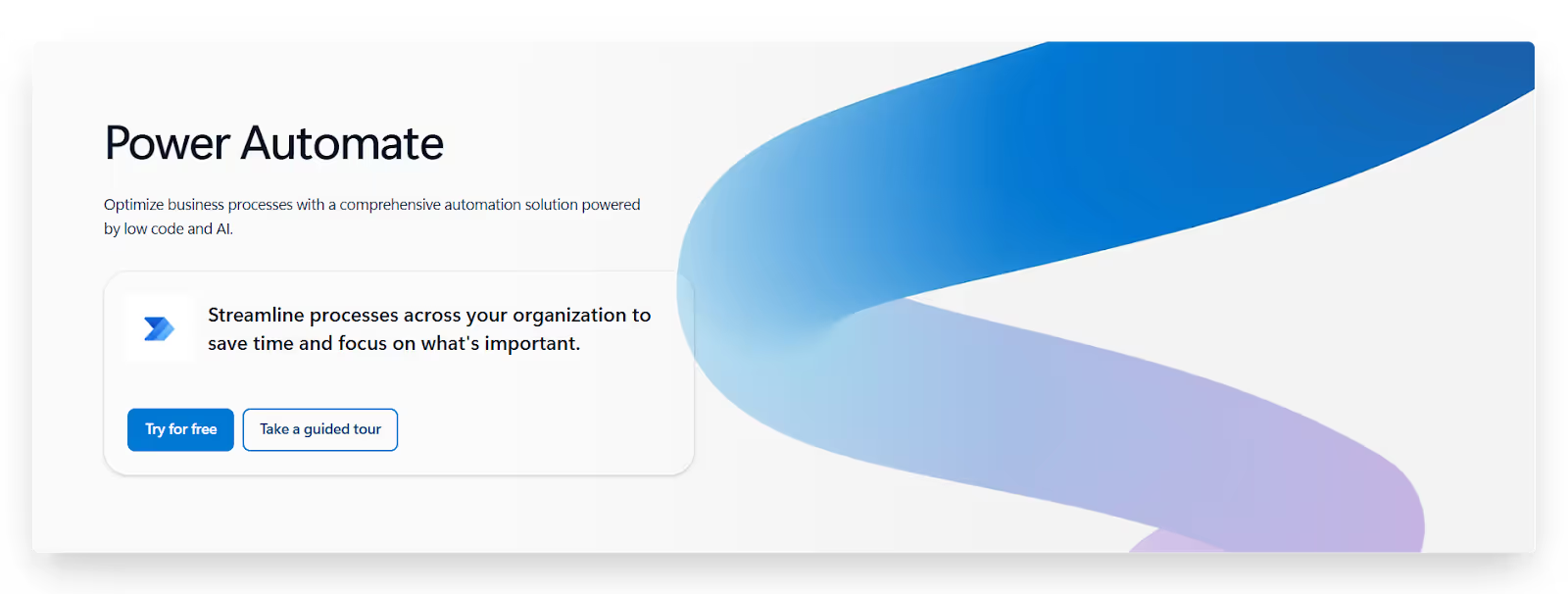
Unique features: Deep Microsoft ecosystem integration, AI-powered automation suggestions, desktop automation capabilities, and enterprise-grade security and compliance features.
Limitations: Works best within the Microsoft ecosystem, and some advanced features require technical knowledge. Businesses not using Microsoft services may find better value in platform-agnostic alternatives.
Read more | Best No-code Mobile App Builders
Key Features to Look For in a No-code Automation Tool
Choosing the right no-code automation tool depends on the features it offers. A good platform should be easy to use, flexible, and secure enough to handle your business needs. Here are the key features to look for:
- Visual workflow builder (drag-and-drop)
A good platform should use a clear visual flowchart or drag-and-drop editor to map out your workflow. This makes it easier to understand each step, connect actions, and make updates without coding. - Templates and prebuilt connectors
Many platforms offer ready-to-use templates and connectors for tools like Gmail, Slack, Google Sheets, or CRMs. These save time and make setup easier. - Two-way sync vs one-way automation
Some tools only send data in one direction. Two-way sync lets changes in one app update another in real time, keeping everything consistent. - Conditional logic and data mapping
You should be able to set conditions like “if X happens, do Y” and map data between tools easily. This adds flexibility and control to your workflows. - User roles and permissions
The ability to assign roles ensures that only authorized users can edit, view, or run specific workflows—important for team collaboration. - Security
Look for SSL encryption, secure storage, and compliance with standards like GDPR to protect sensitive data. - Scalability
The tool should support growing workloads, users, and apps without slowing down or requiring a full rebuild. - Governance support
Features like logs, usage limits, and approval flows help manage automations at scale, especially in larger teams or regulated industries.
Read more | Build Marketplace Platform Guide
How to Choose the Right No-code Automation Platform
Picking the right no-code automation platform depends on your team’s needs, skill level, and how complex your workflows are. Here are key points to help you decide:
- Match tool to your team’s technical skill
If your team has no coding experience, choose tools with simple drag-and-drop interfaces like Glide or Zapier. For teams with some technical skills, Make.com offers more advanced control and flexibility. - Check available integrations
Make sure the platform supports the tools you already use—like Gmail, Slack, Google Sheets, or your CRM. Built-in integrations save time and reduce the need for custom setups. - Evaluate workflow complexity (simple vs advanced)
For basic tasks like sending emails or updating sheets, simple platforms work fine. If your workflows involve multi-step processes, filters, or conditional logic, choose a tool that supports complex automation. - Compare pricing, support, and scalability options
Look at the pricing model based on users, tasks, or data volume. Check for free trials, support quality, and how well the platform scales as your needs grow.
Choosing the right platform ensures you get the best mix of ease, power, and value—without overpaying or hitting limits too soon.
Read more | Build Social Media App with No-code
Trends in No-code Automation
One major shift is the rise of AI and large language models (LLMs) like OpenAI and Gemini. These tools are now being used to power UI automation, allowing platforms to generate workflows or suggest automations based on plain text commands. This makes building automations even easier for non-technical users.
At the same time, demand for no-code automation is growing across industries—from healthcare to finance—as teams look to improve efficiency without hiring large tech teams. What was once used for small tasks is now becoming a core part of business operations.
In 2025, automation is no longer just a bonus—it’s expected. Companies are relying on it for everything from client onboarding to IT workflows, making it a vital part of staying competitive in today’s fast-moving digital world.
Ready to transform your business operations with intelligent automation? Book a free discovery call with LowCode Agency to discover how we can help you build custom automation solutions that drive real results and position your organization for sustainable growth.
Created on
September 17, 2023
. Last updated on
August 5, 2025
.

FAQs
What is no-code automation?
How does no-code automation work?
Can no-code automation be customized to specific business needs?
Is no-code automation suitable for small businesses and startups?
What are some popular no-code automation platforms?
Can I automate complex workflows without coding?





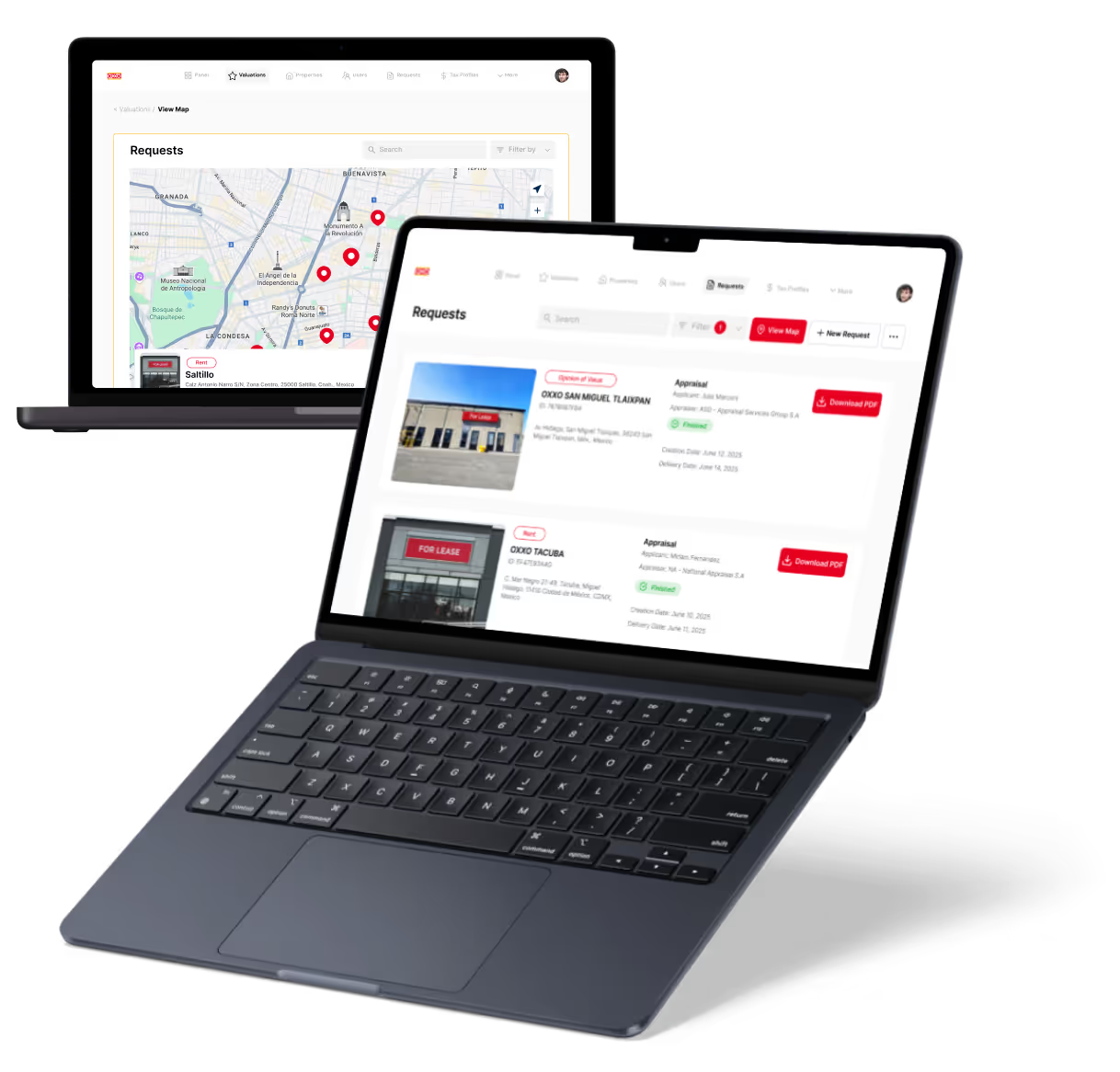

%20(Custom).avif)




